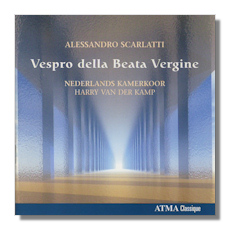
The Internet's Premier Classical Music Source
Related Links
- A. Scarlatti Reviews
- Latest Reviews
- More Reviews
-
By Composer
-
Collections
DVD & Blu-ray
Books
Concert Reviews
Articles/Interviews
Software
Audio
Search Amazon
Recommended Links
Site News
 CD Review
CD Review
Alessandro Scarlatti

Vespro della Beata Vergine
Roberto Fernández de Larrinoa, violin
Menno van Delft, organ
Nederlands Kamerkoor/Harry van der Kamp
Atma Classics ACD2-2533
This is a somewhat speculative 'construction' of a Vespro culled from a variety of movements whose scores were formerly distributed in libraries across Europe. We don't know a great deal about them – except that they were composed late in Scarlatti's life (1660-1725). Though only in the case of the Laetatus sum can a date be ascribed for sure: April 1717. At that time, Scarlatti seems to have been working alternately in Rome and Naples. Some have pointed to what the seven movements have in common: the use of a cantus firmus, the fact that they are all written for five parts, the extent to which the component psalms successfully bridge antico and moderno styles, and a certain gentility, a grace which confers upon the work (which lasts just an hour) a serenity and sense of peace. The latter in particular is very well conveyed by the Nederlands Kamerkoor under Harry van der Kamp.
The singers approach the tuneful and unambivalently confident melodies and textures in which Scarlatti balances delicate individual writing with ensembles to produce an uplifting reflection on the relationship, perhaps, between faith and celebration. Scarlatti even uses the term "violence" in one of his commentaries suggesting explicitly that the tension between consonance and dissonance results in a particular kind of harmony based on the listener's awareness of both states. The singers are completely at home with the demands which this attention to structure makes on them. Indeed, the composer likened these techniques to the visual chiaroscuro effect – current at the time. Interestingly, he felt often that he had to defend himself against the charge that his music was melancholy. Again, the performers on this CD make no mistake in that direction. They approach the music knowing that it has depth and pathos. But is never lugubrious or turgid. In other words, the singers are not covertly hinting at a dark side to the act of rejoicing. But suggesting that rejoicing can (perhaps should) rarely be untouched by reserve. This is reflected, for example, in some of the tempi chosen.
In fact, it's really a lightness and openness throughout that characterizes this performance. Not quite sprightly, nor springy – that would have been inappropriate – but full of life and a quiet celebration, as befits the liturgical purpose for which the psalms were written. Pleasingly, van der Kamp also avoids any hint of rhetoric which could have been used to give the music a spurious excitement. It does not need it. It particularly does not need anything melodically superfluous when you remember that the texts of the psalms were intended to carry the meaning. Whether this intention to emphasize the uplifting aspects of Vespers was at the request of the patron(s) for whom the work was probably composed, or intrinsic to Scarlatti's own vision, is not clear; perhaps it's also immaterial. In the end the elegance yet tensile beauty of the music stands in its own right and makes for very satisfying listening in the hands of performers as expert as these.
The CD is nicely presented – well up to Atma's usual standards with a short but informative essay as much on the life and musical context of Scarlatti senior as on this work, and the text in Latin, French and English. The acoustic is unfussy and promotes clear listening. An out of the way work that will appeal to lovers of the Italian mid-Baroque. There is no other recording in the catalog: indeed, this is a world première and well worth investigating.
Copyright © 2010, Mark Sealey.





















